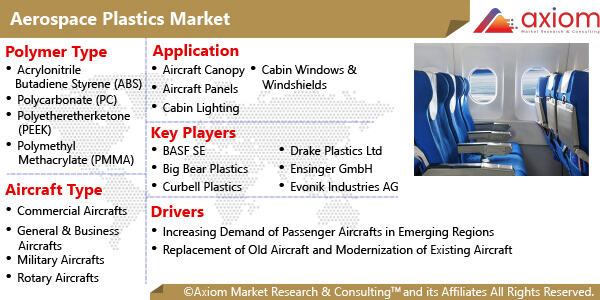Technical and high performance aerospace plastics contribute to making applications more efficient and competitive in many areas of industry. The characteristics of high-performance and engineering plastic materials meet the technical requirements for many of the systems and subsystems used in today’s ultra-modern advanced composite aircraft. The advantages of using lower weight materials for producing fuel efficient and low emission aircraft are clear, but there may also be benefits gained from the longer service life of components. Additionally, aerospace materials are not affected by corrosion in the aviation operating environment. The impressive properties of high performance plastics include their low weight and high strength. Significant weight savings can be achieved by switching from aluminum/steel. Moreover, High-performance plastics have to show special properties in their resistance to chemicals, in order to be used in the aviation and aerospace industry. This depends on the state of the part, the geometry and the internal stress of the materials. More recently, due to the significance increase of high-performance plastics and composites in aviation and aerospace applications, the market for aerospace plastic is projected to propel in near future.
Aerospace Plastic Market Outlook
Factors such as increasing demand for lightweight and more efficient aircraft, rising demand of passenger aircrafts in emerging regions and rise in demand for plastics due to low cost & physical properties are driving the aerospace plastic market. In addition, modernization of existing aircraft is also the factor driving the aerospace plastic market. However, lack of standardization in manufacturing technologies and high capital intensive are some major factor hindering the growth of aerospace plastic market globally.
Aerospace Plastic Market Segmentation
The aerospace plastic market is classified into polymer type, aircraft type, application and geography.
Aerospace Plastic Market by Polymer Type
Various polymer types of aerospace plastic market were studied in the report such as polyetheretherketone, polyphenyl sulfide, polycarbonate, acrylonitrile butadiene styrene and polymethyl methacrylate. Among these, polymethyl methacrylate is a transparent thermoplastic and impact resistant substitute of glass. It is highly durable, weather, and chemical-resistant. Moreover, it is lightweight, rigid, and has color versatility. For military aircraft, polymethyl methacrylate is used as an alternative for glass to manufacture airplane windows.
Aerospace Plastic Market by Aircraft Type
The aircraft type discussed in this market are commercial aircraft, general & business aircraft, military aircraft, rotary aircraft and others. Owing to the emergence of several service providers in air transport industry and increasing air passenger traffic are anticipated to increase the demand for commercial aircraft, thus growing the demand for aerospace plastics.
Aerospace Plastic Market by Application
Based on application, the aerospace plastic market is segmented into cabin windows and windshields, cabin lighting, overhead storage bins, aircraft panels and aircraft canopy. Further, the overhead storage bins segment is bifurcated into shelf bin, pivot bin and translating bin. Likewise, aircraft panels is classified into floor panels, ceiling panels and side Panels. Aircraft interior plastic is allowing engineers to design revolutionary airplane layouts that are not only more ergonomic, but more aesthetically pleasing as well. Plastic is much easier to mold and shape than more traditional aircraft materials, like rubber and aluminum, while being much lighter and just as safe.
Aerospace Plastic Market by Geography
The aerospace plastic market report is studied across the key countries of North America, Europe, Asia Pacific and Rest of the World. Due to the urge to modify or replace the existing inefficient aircraft with fuel-efficient airplane, the North America region is projected to witness the largest market share in the aerospace plastic market.
Aerospace Plastic Market Key Players
The market involves various key companies in the global aerospace plastic market such as SABIC, Victrex, Drake Plastics Ltd, Solvay, BASF SE, Evonik Industries AG, Vantage Plane Plastics, Quadrant Engineering Plastics, Paco Plastics & Engineering Inc., 3P - Performance Plastics Products, Polyflour Plastics, Big Bear Plastics, Grafix Plastics, Loar Group, Zeus, Curbell Plastics and Ensinger GmbH. The majority of companies are aiming towards product launches and mergers & acquisitions to enhance their visibility in the high competitive arena of the market.
Aerospace Plastic Market Developments
- September 2018: Victrex partnered with University of Exeter (UK) to introduce next-generation PAEK polymers and composites for additive manufacturing to be used in aerospace industry. This partnership became a stepping stone for both parties to develop a broader platform for new and current additive manufacturing technologies.
- March 2017: Drake Plastics Ltd. Co, added extruded Ryton R4 to its product portfolio. Ryton’s properties and characteristics such as strength, stiffness, and chemical inertness across different environments make it suitable for aerospace applications.
- September 2017: BASF has partnered with the German Aerospace Center (DLR) and NASA Goddard Space Flight Center on a new tool to maximize the service life of plastic products by precisely matching plastic additives to the predicted intensity of ultraviolet (UV) radiation.











